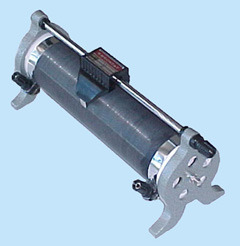Rheostat
A rheostat is an electrical component that has an adjustable resistance. It is a type of potentiometer that has two terminals instead of three. The two main types of rheostat are the rotary and slider. The symbol for a rheostat is a resistor symbol with an arrow diagonally across it. Rheostats are used in many different applications, from light dimmers to the motor controllers in large industrial machines.

Rheostat Construction
Most rheostats are the wire-wound type that have a long length of conductive wire coiled into a tight spiral. The linear type has a straight coil, while the rotary type has the coil curved into a torus to save space. The coil and contacts are sealed inside the case to protect them from dirt, which can cause an open circuit, and from moisture, which can cause a short circuit. Rheostats can be made from other materials such as carbon disks, metal ribbons, and even certain fluids. As long as a material has a significant resistance change over a short length, it can probably be used to make a rheostat.
How Rheostats Work
The basic principle that rheostats use is Ohm’s law, which states that current is inversely proportional to resistance for a given voltage. This means the current decreases as the resistance increases or it increases as the resistance decreases. Current enters the rheostat through one of its terminals, flows through the wire coil and contact, and exits through the other terminal. Rheostats do not have polarity and operate the same when the terminals are reversed. Three-terminal potentiometers can be used as rheostats by connecting the unused third terminal to the contact terminal.
Applications
Some light dimmers use rheostats to limit the current passing through the light bulbs in order to change their brightness. The greater the rheostat’s resistance, the lower the light bulbs’ brightness. Some lights cannot use dimmers, such as fluorescents and gas discharge lamps. These lights have large resistance loads called ballasts, that maintain a constant current through them. Rheostats have no effect on their brightness and can even damage them.
Motor controllers also use rheostats to control a motor’s speed by limiting the flow of current through them. They are used in many small appliances such as blenders, mixers, fans, and power tools. Rheostats are also used as test instruments to provide an accurate resistance value. While rheostats can be used to control electric ovens and cooktops, thermostats are preferred because they have additional parts that automatically adjust the current flow to maintain a constant temperature.
The rheostat is still a common and fundamental electronic component used to control the flow of current in a circuit. However, it has largely been replaced by the triac, a solid-state device also known as a silicon controlled rectifier (SCR). A triac does not waste as much power as a rheostat and is more reliable due to the absence of mechanical parts. Rheostats commonly fail because their contacts become dirty or the coil wire corrodes and breaks.


Comments - 34 Responses to “Rheostat”
Sorry but comments are closed at this time.